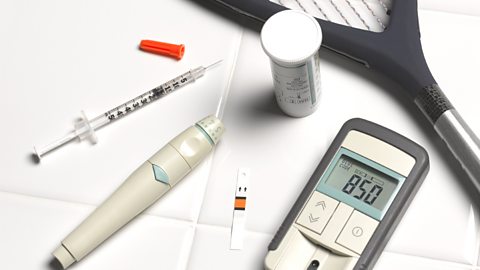Type 1 and Type 2 diabetes
Diabetes
Greg Foot explains the difference between Type 1 and Type 2 diabetes and the role insulin plays in controlling glucose levels
diabetesA serious disease in which the body is unable to regulate blood sugar. is a condition where the blood glucoseA simple sugar used by cells for respiration. levels cannot be controlled effectively.
There are two types of diabetes - Type 1 and Type 2.
Type 1 diabetes
Type 1 diabetes is a disorder in which the pancreas stops producing enough insulin.
This can be detected from an early age. It is characterised by uncontrolled high blood glucose levels and it can be controlled by injecting insulin.

It can be treated by injecting insulinA hormone that regulates the level of sugar in the blood and can be produced by genetically modified bacteria.. The extra insulin causes the liver to convert glucose into glycogen, which reduces the blood glucose level.
People with Type 1 diabetes have to monitor their blood sugar levels throughout the day. Their levels of physical activity and their dietThe type and amount of food consumed by people. affect the amount of insulin needed.
They can help to control their blood glucose level by being careful with their diet, and eat foods that will not cause large increases in blood sugar level, and by exercising, which can lower blood glucose levels due to increased respirationThe chemical change that takes place inside living cells, which uses glucose and oxygen to release the energy that organisms need to live. Carbon dioxide is a by-product of respiration. in the muscles.
Type 2 diabetes
In Type 2 diabetes the person's body cells no longer respond to insulin produced by the pancreas. It is more common in older people. It can be managed by eating a carbohydrateFood belonging to the food group consisting of sugars, starch and cellulose. Carbohydrates are vital for energy in humans and are stored as fat if eaten in excess. In plants, carbohydrates are important for photosynthesis. controlled diet and an exercise regime.
Type 2 diabetes can also be controlled using insulin injections to increase the levels of insulin so that the body responds to it. However, this is not effective in the long term, unlike with Type 1 diabetes.
Carbohydrate is digested into glucose, which raises the overall blood glucose level. There is a positive correlationIn a scatter graph, when one quantity increases and the other decreases, the correlation is called positive correlation. between rising levels of obesityThe medical term for being very overweight, owing to the excessive accumulation of body fat. in the general population and increasing levels of Type 2 diabetes.
Question
Use the graph to describe the patterns in this data.
The graph shows a range of data from 1990 to 2000. meanThe total of the numbers divided by how many numbers there are. body weight has steadily increased from approximately 72.5 kg in 1990, to just over 77 kg in 2000.
This correlates with a general increase in the number of people with Type 2 diabetes. For example, the percentage was just below 5 percent in 1990 up to just below 7.5 percent in 2000. This shows an overall increase in 2.5 percent over 10 years.
Comparing Type 1 and Type 2 diabetes
| Type 1 | Type 2 | |
| Cause | Pancreas stops making insulin | Body no longer responds to its own insulin (though pancreas will still make it) |
| Consequence | Blood glucose levels remain too high | Blood glucose levels remain too high |
| Use of insulin injections | Puts insulin into the bloodstream as the person cannot make insulin | Increases the amount of insulin in the blood to levels that will cause a response |
| Use of exercise | Exercise causes glucose to be used up in respiration so lowers blood glucose levels | Exercise causes glucose to be used up in respiration so lowers blood glucose levels |
| Use of diet | Person should avoid eating foods that are high in sugar | Person should eat a carbohydrate controlled diet |
| Age of onset | Younger children | Older people |
| Cause | |
| Type 1 | Pancreas stops making insulin |
| Type 2 | Body no longer responds to its own insulin (though pancreas will still make it) |
| Consequence | |
| Type 1 | Blood glucose levels remain too high |
| Type 2 | Blood glucose levels remain too high |
| Use of insulin injections | |
| Type 1 | Puts insulin into the bloodstream as the person cannot make insulin |
| Type 2 | Increases the amount of insulin in the blood to levels that will cause a response |
| Use of exercise | |
| Type 1 | Exercise causes glucose to be used up in respiration so lowers blood glucose levels |
| Type 2 | Exercise causes glucose to be used up in respiration so lowers blood glucose levels |
| Use of diet | |
| Type 1 | Person should avoid eating foods that are high in sugar |
| Type 2 | Person should eat a carbohydrate controlled diet |
| Age of onset | |
| Type 1 | Younger children |
| Type 2 | Older people |
More guides on this topic
- How do substances get into, out of and around our bodies?
- How does the nervous system help us respond? - OCR 21st Century
- Why do we need to maintain a constant internal environment?
- What role do hormones play in human reproduction? - OCR 21st Century
- Sample exam questions - the human body - staying alive